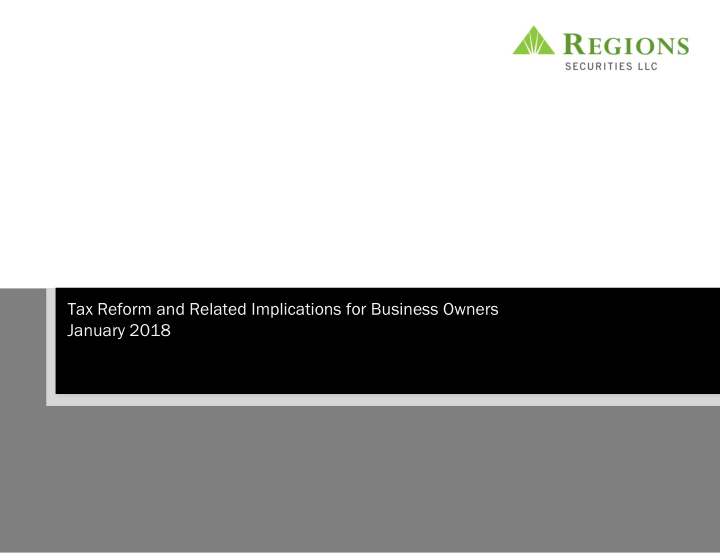



Tax Reform and Related Implications for Business Owners January 2018
Tax Reform Summary Snap apsho hot Overvie iew • On Wednesday, December 20, 2017, Congress approved a sweeping $1.5 trillion tax bill that modified tax rates for corporations, provided new breaks for private businesses, and reorganized the individual tax code. The tax reform was the largest overhaul of the U.S. tax system since 1986 • The Tax Cuts and Jobs Act, or the Act, replaces the graduated corporate income tax with a flat 21.0% rate, the lowest rate since 1939 − To partially offset the cost of lower rates, the Act would modify or eliminate a number of credits and deductions − Many of the major individual provisions, including changes for pass-through businesses, will sunset after 2025 • The Act also includes fundamental changes to the taxation of multinational entities, including a shift from the current system of worldwide taxation with deferral to a hybrid territorial system − Features a participation exemption regime with current taxation of certain foreign income, a minimum tax on low-taxed foreign earnings, and new measures to deter base erosion and promote U.S. production • The Act is expected to reduce government revenue by $1.5 trillion in fiscal years 2018 through 2027 on a static basis, according to a joint analysis from the Congressional Budget Office (CBO) and the Joint Committee on Taxation (JCT) − The reduction in revenue would be partially offset by a $194.0 billion reduction in outlays Cost Recover ery Inter erest Deduc uction n Net Operating ing Loss Deduc uction Corporat ate Rate e and Deduc uctio ions ns • The previous top rate of 35.0% • The net interest expense • The net operating loss deduction • Allows for full and immediate has been replaced by a flat 21.0% deduction would be limited to carryover would be limited to expensing of capital investments corporate income tax rate 30.0% of a business’s adjusted 80.0% of a taxpayer’s eligible placed in service after Sept. 27, beginning in the 2018 taxable income income, computed without 2017, and before Jan. 1, 2023 consideration of the deduction From 2018 through 2021, After 2023, “bonus” or • • itself adjusted taxable income would be “accelerated” depreciation would considered earnings before The ability to carry back a loss to phase out by 20 percent per year • interest, taxes, depreciation, and a previous year would be through 2026 (or through 2027 amortization (“EBITDA”). In repealed, but losses could be for property that qualified for an subsequent years, the deduction carried forward indefinitely extra year of full expensing) would be reduced to earnings before interest and taxes (“EBIT”) 2 | Regions Securities LLC
Tax Reform Summary Key Comp mponen onents ts Items ms New Legisl islati tion on Previou ious s Legisla gislati tion on • Seven brackets of rates, starting 10.0% and reaching as high as • Seven brackets of rates, starting 10.0% and reaching as high as 39.6% for Individual Tax Rates 37.0% for income above $500,000 for single filers and $600,000 income above $418,401 for single filers and $470,701 for married, joint filers (Effective 2018-2025): for married, joint filers Corporate Tax Rate: • 21.0%, beginning in 2018 • 35.0% • Repealed • Applies a 20% rate as part of a parallel tax system that limits tax benefits to Corporate Alternative prevent large-scale tax avoidance. Companies must calculate their ordinary tax Minimum Tax: and AMT tax, and pay whichever is higher • Businesses could fully and immediately deduct the cost of certain • Businesses must take depreciation, spreading the recognition of their Cost Recovery equipment purchased after Sept. 27, 2017 and before Jan. 1, equipment costs for tax purposes over several years (Accelerated 2023. After that, the percentage of cost that could be immediately Depreciation): deducted would gradually phase down • U.S. companies’ overseas income held as cash would be subject to • The U.S. taxes multinationals on their global earnings at the corporate rate of Repatriation: a 15.5% rate, while non-cash illiquid holdings would face an 8.0% 35%, but allows them to defer taxes on those foreign earnings until they bring rate them back to the U.S., or “repatriate” them • Owners could apply a 20% deduction to their business income, • Pass-through businesses, which include partnerships, limited liability Pass-Through subject to limits that would begin at $315,000 for married couples companies, S corporations and sole proprietorships, pass their income to their Deduction: (or half that for single taxpayers) owners, who pay tax at their individual rates Standard Deduction • $12,000 standard deduction for single taxpayers and $24,000 for • $6,350 standard deduction for single taxpayers and $12,700 for married and Personal married couples, filing jointly. Personal exemptions repealed couples, filing jointly. Personal exemptions of $4,050 allowed for each family Exemptions: member • Individuals can deduct no more than $10,000 worth of the • Individuals can deduct the state and local taxes they pay, but the value is Individual State and deductions, which could include a combination of property taxes subject to certain limits for high earners Local Tax Deductions: and either sales or income taxes • Deductible mortgage interest for new purchases of first or second • Deductible mortgage interest is capped at loans of $1 million Mortgage Interest homes would be capped at loans of $750,000 starting on Jan. 1, Deduction: 2018 • Double the thresholds so the levy applies to fewer estates. The • Applies a 40% levy on estates worth more than $5.49 million for individuals and Estate Tax: higher thresholds would sunset in 2026 $10.98 million for couples Sources: Bloomberg, PWC, Deloitte, Moody’s 3 | Regions Securities LLC
Recommend
More recommend